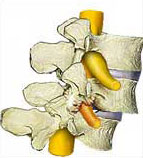Additional Resources
- NOTE: This list provides links to external on-line resources. Each link will open a new browser window.
- North American Spine Society a non-profit corporation
- Cervical Spine Research Society
- Scoliosis Research Society
- The International Spine Intervention Society
- American Academy of Pain Medicine
- American Pain Society
- A-O North America
- American Academy of Physical Medicine and Rehabilitation
- American Academy of Orthopaedic Surgeons
- American Association of Neurological Surgeons
- Back.com
- Neck Reference
- iScoliosis


- Notice of Disclaimer for external resource links.
The Spine Institute does not support nor endorse any of the resources listed above. They are provided for informational purposes only, and is not a comprehensive list.
Symptoms of a Spondylolisthesis
 There are different causes of spondylolisthesis. The congenital form
(being born with abnormalities which contribute to the displacement)
is a rare cause. Other causes include trauma (sudden falls, accidents,
etc.), degenerative changes in the spine (like arthritis), or destruction
by tumors.
There are different causes of spondylolisthesis. The congenital form
(being born with abnormalities which contribute to the displacement)
is a rare cause. Other causes include trauma (sudden falls, accidents,
etc.), degenerative changes in the spine (like arthritis), or destruction
by tumors.Spondylolisthesis is characterized by the percentage of displacement of one vertebra over another). Displacement of over 50% is considered high grade.
Treatment Options for Spondylolisthesis
The treatment of spondylolisthesis is usually non-surgical. Physical therapy to strengthen the back and abdominal muscles is the primary mode of treatment. Medication such as NSAIDS (aspirin, Aleve, etc.), steroids or narcotics can help with the pain and inflammation. Epidural injections can also be effective, especially with leg symptoms. Surgical treatment becomes necessary when conservative management fails. Surgery is especially effective for patients with leg symptoms.- Medications
- Injections
- Physical Therapy
Conservative Treatments:
- Spinal Fusion
- DYNESYS® Spinal System
Surgical Treatments:
Latest news
Visit our media library for access to all of our news videos.
The Spine Institute is often in the news pioneering new treatments to help the reported 34 million Americans 18 years and older who suffer lower back pain, and another 9 million who suffer neck pain. Watch the news coverage here.
